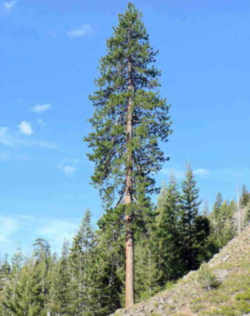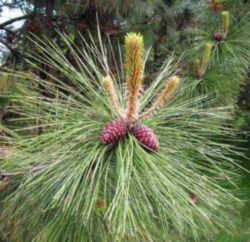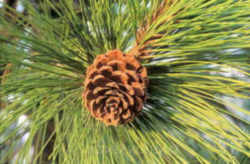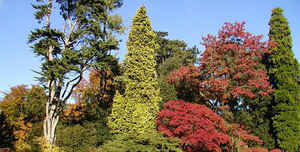
Montana Symbols
Montana State Tree
Ponderosa Pine

(Pinaceae Pinus ponderosa)
Adopted in 1949.
Ponderosa Pine, (Pinus ponderosa,)was designated as Montana's official state tree in 1949. Also known as Western Yellow Pine, Bull, Black Jack, Western Red, Sierra Brownbark, Heavy, and Western Pitch, Montana's state tree has a long list of names.
This stately western Montana resident has figured heavily in the
development of all the West. American Indians traditionally ate the seeds
and inner bark, dug out logs for canoes, and used the pitch as waterproofing
and ointment. The bark of the Ponderosa Pine has a smell similar to vanilla.
Montana State Tree: Ponderosa Pine

Pinus ponderosa, commonly known as the ponderosa pine, bull pine, blackjack pine, or western yellow pine, is a very large pine tree of variable habit native to western United States and Canada. It grows in various erect forms from British Columbia southward and eastward through 16 western states. It has been successfully introduced in temperate regions of Europe. It was first seen and collected in 1826 in eastern Washington near present-day Spokane. On that occasion David Douglas misidentified it as Pinus resinosa. In 1829 Douglas concluded he had a new pine among his specimens and coined the name Pinus ponderosa for its heavy wood. In 1836, it was formally named and described by Charles Lawson, a Scottish nurseryman
In what is now South Dakota, Lewis and Clark first observed the cones of the ponderosa pine which had floated that far on the currents of the Missouri
River. Captain Lewis, particularly, took extensive notes on the tree as he passed through its habitat later during the journey west and back, but his
untimely death in 1809 delayed any serious scientific study of the tree until the end of the 19th century.
Pioneers needed no detailed report to encourage their use of the pine's wood for the civilization they were building. Ponderosa timber served everywhere,
from railroad ties and telegraph poles to mine bracing and homes. Only later did its long needles and attractive cones garner more scientific consideration.
In the spring of 1908, Helena's school children held a referendum on which tree best represented the state. The ponderosa easily outdistanced fir,
larch, and cottonwood for the designation.
It was not until 1949, however, that the Montana Legislature bestowed its blessing. The Montana Federation of Garden Clubs carried on a year-long campaign
on behalf of the ponderosa. The state forester supported it as the "most typical" of all Montana trees and the best commercial timber... "king of the
forest," he called it. The Legislature agreed.
Identification of the Ponderosa Pine

Leaf: Evergreen, 5 to 10 inches long, with three (sometimes 2) tough, yellow-green needles per fascicle. When crushed, needles have a turpentine odor sometimes reminiscent of citrus.
Flower: Monoecious; males yellow-red, cylindrical, in clusters near ends of branches; females reddish at branch tips.
Fruit: Cones are ovoid, 3 to 6 inches long, sessile, red-brown in color, armed with a slender prickle. Maturing August to September.
Twig: Stout, orange in color, turning black. Buds often covered with resin.
Bark: Very dark (nearly black) on young trees, developing cinnamon-colored plates and deep furrows.
Form: A large tree with an irregular crown, eventually developing a flat top or short conical crown. Ponderosa pine self-prunes well and develops a clear bole.
Montana Law
An icon of western North America, the Ponderosa Pine, (Pinaceae Pinus ponderosa,) was adopted in 1949 as the state tree.
Taxonomic Hierarchy: Ponderosa Pine Tree
Kingdom: Plantae - Plants
Subkingdom: Tracheobionta - Vascular plants
Superdivision: Spermatophyta - Seed plants
Division: Coniferophyta - Conifers
Class: Pinopsida
Order: Pinales
Family: Pinaceae - Pine family
Genus: Pinus L. - pine
Species: Pinus ponderosa Lawson & C. Lawson - ponderosa pine







